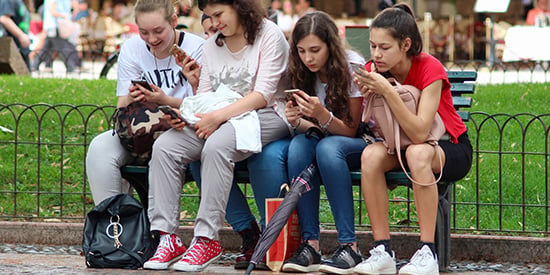Teen tracking study shows they spend most waking hours sitting down
Media release
Australian teenagers sit for more than two-thirds of the day, which may increase their risk of physical and social health problems, according to a first-of-its-kind study from Deakin University's Institute for Physical Activity and Nutrition (IPAN).
The study, published today in the journal BMC Public Health, tracked nearly 400 students at 18 Victorian high schools using 'activPALTM' wearable devices, which measure not only movement but also differentiate between time spent sitting, standing and lying during different periods of the day.
Lead author Dr Lauren Arundell, an Alfred Deakin Postdoctoral Research Fellow in IPAN, said the highest percentage of sitting time occurred during class, where students sat for 75 per cent of the time. This was followed by evenings, where 73 per cent of time was spent sitting.
Dr Arundell said she hoped the data from her study would help inform the times of day where interventions are needed to get teenagers sitting less and moving more.
"Our data suggests that the school timetable is an important contributor to adolescent sitting patterns," she said.
"The introduction of standing or active class lessons, where students are encouraged to stand and move around while completing their work, can be an effective way of getting students to sit less and move more at school.
"But we also need to look at ways to make homework and recreation time less sedentary as teenagers spend almost three-quarters of the evening period between 6pm and 10pm sitting."
Dr Arundell said this could be through modifying homework to incorporate more group or creative activities that require movement, and by encouraging teenagers to break up their sitting and move as often as possible.
"Teens are typically driven to school, sit at school, driven home, do their homework, and then watch TV or play video games and go to bed. That equates to far too much sitting time and is only exacerbated by the ubiquity of personal devices," she said.
"While there's no specific target for a healthy amount of sitting time, Australian guidelines recommend that youth limit their recreational screen time to less than two hours per day and break up periods of sitting as often as possible. At the moment less than one in three teenagers are meeting that goal."
Dr Arundell said there was emerging evidence that long periods of sitting was detrimental to physical, social and mental health.
"Recent studies have shown that teens who break up their sitting have lower diabetes risk factors than peers who remain sitting," she said.
One of Dr Arundell's studies, published late last year, also found that teenagers who spent more time participating in sedentary behaviours - specifically screen time, computer/video game use and homework - had lower social connectedness.
"Conversely, evidence also shows that kids who sit less and move more have better academic outcomes," she said.
The data gathered for this study was part of the international NEArbY project investigating neighbourhood activity in youth. NEArbY was funded by the National Institutes for Health (NIH; R01 HL 111378).

